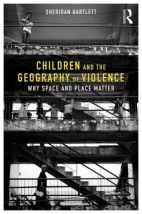Children and the Geography of Violence: Why Space and Place Matter

Children and the Geography of Violence expands upon the social–ecological perspective of violence to consider how the physical environment is integral to the issue of violence and what its implications are for children, in particular. Bartlett argues that violence can be deeply embedded in the production and control of children’s material and spatial environments, and therefore this tangible form of structural violence needs consideration if we are to effectively tackle violence against children. She articulates her goal for the book as: “an expanded paradigm for child protection, one anchored in the transformative potential of community-driven development, undertaken in negotiation and collaboration with the local state” (page 8). And to achieve this, Bartlett draws upon empirical research from North America to India across several decades, with specific attention to poor communities in the global South.
Seven chapters frame this book and progressively add layers to Bartlett’s argument. She starts in Chapter 1 by laying down the territory on violence against children and why she believes the physical environment plays an integral role. Bartlett then explains how expanding the definition of violence to incorporate this dimension in fact can “widen and deepen the opportunities for practical action” (page 6).
Chapter 2 builds on the first chapter to provide a background to violence against children. Bartlett starts with a global overview of the prevalence of violence against children. She then identifies the significance of structural violence. Bartlett continues to consider the role of stress for violence and how violence impacts upon children. Finally, she explores how the physical environment contributes to risk and protection.
In Chapter 3, the experience of violence for children at home is expounded. The bulk of the chapter is used to identify specific aspects of “home” that affect the experience of violence. These are: the physical ecology of abuse and neglect, material conditions, housing quality, housing security, neighbourhood conditions, and children in residential care.
Chapter 4 moves to the neighbourhood scale. Here Bartlett discusses how children’s experience of violence is affected by tensions over shared space; service provision, amenities and disamenities; hotspots and environmental design; spatial segregation; and power and insecurity in fragile cities. She continues to then consider the attraction of violence for children as well as the experience of violence at both school and work.
In light of refugees and migrants, Chapter 5 considers the experience of violence for children when home and neighbourhood are lost. This starts by looking at migration and trafficking and moves to consider living on the street and being a refugee or internally displaced person, and the everyday experiences of violence and distress that accompany these.
Chapter 6 commences Bartlett’s concluding chapters. Here she articulates the reach of current strategies to eliminate violence against young children and advocates why their paradigm needs to expand to include the social–ecological perspective fleshed out in Chapters 3 to 5. In particular, Bartlett articulates how child protection programmes should build on community-driven development that responds to material deprivations (page 114).
The final chapter presents some responses to space and place from around the world, mostly community-driven efforts in Asia. These include housing security, housing that works for families, neighbourhood space and amenities, safety in school and on the school journey, and crime prevention through environmental design and supportive policing. Bartlett suggests that these “might contribute to ensuring the protection of local children” or could serve as entry points (page 135).
The wealth of empirical knowledge here and the intrinsic interest of the topic bring this book alive. It is useful reading for development practitioners, urban planners, local government and academics, as it links the physical environment with children’s experience of violence.
Book note prepared by Hannah Keren Lee
Search the Book notes database
Our Book notes database contains details and summaries of all the publications included in Book notes since 1993 - with details on how to obtain/download.
Use the search form above, or visit the Book notes landing page for more options and latest content.
For a searchable database for papers in Environment and Urbanization, go to http://eau.sagepub.com/

